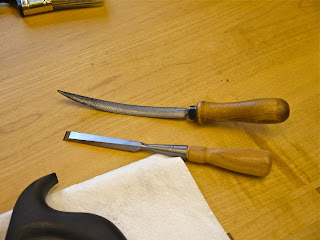I was contact by Noel Logier of Logier Rasp inquiring as to whether I would be interested in trying one of his rasp made especially for tool tote shaping. They call it a "Handle Makers Rasp" and it comes stitched as a #9, #12 or #15. I was of course interested and we decided that the #12 stitching might be the most appropriate set up for my work. I've shown the rasp along side a Lie-Nielsen socket chisel for size comparison and also because I use that chisel a great deal in my tote shaping work.
Let me make something clear. This tool was offered as a trial, not a free tool and should I decided to keep this rasp (and I most probably will) I will be paying full price for the pleasure of having this tool at my disposal.
I also have one of the Gramercy rasp made for this application but to date I've not had the pleasure of trying one of the Auriou rasp. I hope to have the opportunity to do so at some point in the future.
So far I have shaped three tool totes with the Logier rasp and I've rather enjoyed the use of this tool. One thing that was apparent straight away was that this rasp was not as broad across the width as the other rasp that I've used for this task. Some might say that one could vary the width given the tapering shape of the tool and that is true. However I find the overall narrower width makes this tool quite versatile. In other words with a narrower width you can shape areas of the tote to the shape you prefer rather than have parts of the tote conform to the shape of the rasp. This feature also makes it easier to reach into areas that are difficult to access with a tool of more width.
This rasp removes material quite quickly and effortlessly. I can't imagine for my use I would never need this rasp stitched #9. In fact I really think I might benefit from following this tool with a #15 stitched tool in lieu of a coarse grit of sand paper to clean up prior rasp marks. Any sanding I can eliminate makes me happy. Finer work is possible using this tool just by using lighter pressure. This is especially important when making the transitions on brittle edges of dense woods. This same rasp with #15 stitching could possibly work even better in that situation.
I do however have one gripe. This is not directed solely at the Logier rasp. In fact this problem resides in all the tools of this type that I'm aware of. My gripe is with the quality of the wooden handles that come with these tools. If you look closely at the photo below you'll see the stark contrast of the well finished hornbeam handle that comes with the L-N chisel as compared to the non-descript, barely adequate handle supplied with this rasp. This tool would be a great deal more pleasurable to use if the handle were made from a well refined close grained or dense hardwood.
We are presently living in a golden age of tool making of which I am proud to be a part. When I pickup one of my Lie_Nielsen, Blue Spruce, Czeck Edge or Elkhead hand tools the way the handle feels in my hand is very pleasurable. Given the relatively small size there's really no reason these rasp should be any different. I for one would be more than willing to pay a bit extra to obtain a tool with a high quality, well refined handle.
I understand that Lie-Nielsen Tool Works supplies their own handles with the Auriou rasp that they sell. Obviously they felt the same about this part of these tools.
Overall I like this rasp a great deal and it certainly is a tool that makes this task easier to accomplish. I'd certainly recommend this tool to anyone that has a fair amount of this type of work to accomplish, which would certainly justify the expense. I've certainly benefitted from having the opportunity to work with this tool and I look forward to using it a great deal more in the future.
Ron
"some days in the shop I feel like a complete idiot, other days I feel like an absolute genius......in reality I'm never either one"




Ron,
ReplyDeleteI have had one of these rasps for some time in a 12 grain stitch, this gets used for many things I had not anticipated. Of course its perfect for the inside curve on a guitar neck, but I often use for those hard to get at spots on a rocker backrest where it attaches to he back legs too.
I am sure you will be sending a cheque to Noel before too long.
BTW - I have a nice piece of local hornbeam drying to turn for handles for some of my rasps.
How about Black Locust for tool handles?
ReplyDeleteTico given the small amount of wood required any dense hardwood would work wonderfully whether it be Black Locust or cocobolo, olive, or some type of ebony. Anything that takes a nice natural polish would feel wonderful in the hand.
ReplyDeleteRon
I grow Black Locust and will send you some blanks to fool with at your leisure.
ReplyDeleteRon - Do you have any Koa left over? That would make a beautiful handle.
ReplyDeleteYou didn't make much reference in comparison to the Gramercy rasp. If you could only buy one which is my case, which would you prefer? Also for making saw handles could you get away with just a #15 or would the #12 be better??
ReplyDelete